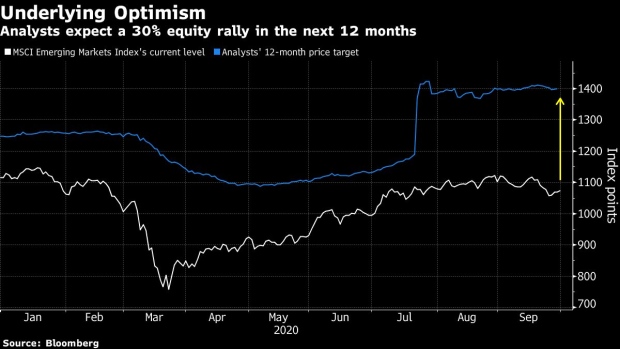Sep 30, 2020
Time to Get Exposed: Election Flux May Be Emerging-Market Moment
, Bloomberg News

(Bloomberg) -- A roller-coaster ride in the third quarter has left emerging-market investors bracing for more swings in the fourth.
Yet that may turn out to be a buying opportunity -- at least for those who can keep their nerve.
The outlook for corporate profits in the developing world is improving at the fastest pace since March 2017, making analysts the most optimistic in 14 years about future equity returns. Bonds are holding on to positive real returns too, despite the re-emergence of inflation, while currencies are beginning to benefit from broad U.S. dollar weakness.
Put together, such positives offer a beacon of comfort for emerging-market traders just five weeks away from one of the most divisive U.S. presidential elections in living memory. If they can stomach the inevitable gyrations of the final three months of 2020, they may come out of it in a position to benefit from the higher yields offered by emerging-market assets and the widely anticipated economic recovery next year.
Emerging Markets on Edge as Goldman and Deutsche Bank Flag Risks
“The fourth quarter is going to be a rough ride for markets globally,” said Simon Quijano-Evans, the London-based chief economist at Gemcorp Capital LLP. But beyond short-term volatility, investors can expect, a “growth rebound, given all the central bank monies pumped into the system and, hopefully, global policy consolidation that will pave the way for more growth,” he said.
That may explain the prevalence of a clutch of optimistic market metrics, even after September’s selloff.
For stocks, investors are betting on a 30% rally over the next 12 months, with the benchmark MSCI gauge expected to surpass its previous record level set at the height of a credit boom in the 2000s. The consensus forecast for the gauge increased by 24% in the past quarter, the biggest jump since 2006. Earnings estimates, too, have risen for a third month, posting the biggest quarterly increase since March 2017.
Turbulent Cues
There’s still plenty to give pause. Equities may be about to notch up their second quarterly advance, but most of the gains happened in the first week of July -- the market has drifted since. September saw the worst losses since the coronavirus-inspired market panic of March, erasing $612 billion in equity value.
It’s a mixed picture for other assets. Expected currency fluctuations increased 14% in the past quarter, returning to March levels. The volatility spread between emerging markets and Group of Seven nations widened by the most in April. Still, September saw currencies outperforming stocks, signaling that they at last be benefiting from the slide in the dollar.
With inflation inching up in developing nations, many central banks have stopped cutting borrowing costs. That’s helped to keep real rates -- nominal interest rates minus inflation -- for local debt positive after they turned negative in the first quarter.
Dollar-denominated bonds posted their first monthly loss since March, paring their quarterly advances. That, coupled with a quarterly increase in the cost of hedging against sovereign defaults, shows continued caution among investors. But the high-risk spreads also offer an opportunity for the bonds to rally once growth returns, Quijano-Evans said.
“The fourth quarter is likely to present itself as an opportunity for all those reluctant global pension funds to finally start increasing exposure,” he said.
Stocks
- The MSCI gauge posts the first back-to-back quarterly gains since March 2018
- Adds $2.05 trillion in equity value during the quarter
- Valuation discount to U.S. stocks narrows to 33% from 34% in June; still, far cheaper than 27% discount at the start of 2020
- Expected volatility falls in July, but increases in August and September; emerging markets once more have greater volatility than U.S.
Currencies
- The MSCI index of exchange rates adds 2.7% in the quarter, second successive rally
- Implied volatility increases 14% in the quarter; spread with G7 climbs 94 basis points in September
Local Bonds
- Gains in the Bloomberg Barclays gauge of local bonds, 1.9% for the quarter, come from currency moves
- Dollar weakness helps he index add $232 billion in market value
- Average yield increases by most since June 2018, up 17 basis points during the quarter
- Current yield at 3.72% still more than average projected inflation of 3.3%, with real return of 42 basis points
Dollar Bonds
- Benchmark index posts 2.2% gain despite September loss
- Adds $101 billion to market value
- Spread between dollar bonds and local bonds inch closer to zero, as the latter underperform. The gap is just 37 basis points now
- Sovereign spread, measured by a JPMorgan Chase & Co. index, falls to 400 basis points but bounces back; investors not ready to trade at tighter spreads
©2020 Bloomberg L.P.